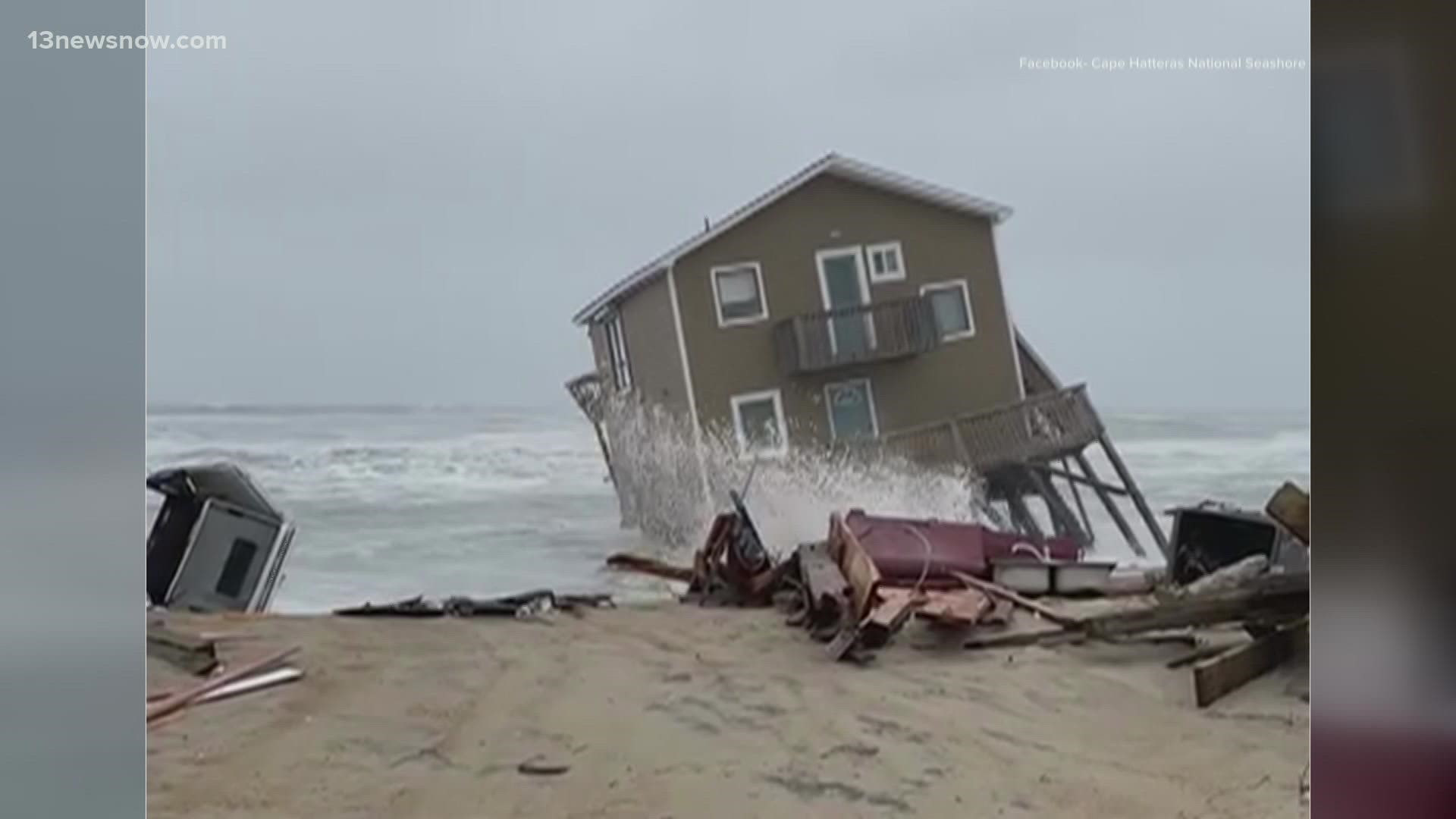RODANTHE, N.C. — The Outer Banks as we know it can change with the tide.
Three homes were washed out to sea this year and more could be in danger of collapse. Now, there's a race to prolong the lifespan of homes and beaches threatened by erosion.
Collapsing homes
July in the Outer Banks is prime vacation time for visitors like Betsy Temple.
“I love Rodanthe. I’ve been coming to Nags Head since I was born,” she said.
When Temple booked her Airbnb in Rodanthe, she didn’t plan to have a direct view of the ocean. But Mother Nature made one for her.
“We pretty much have an Oceanfront view now,” she said. “When we looked at this house in the winter, we had a house on either side of it with a view of the ocean, and unfortunately now they’re gone.”
Ocean Drive is a shell of its former self. The sea claimed the street’s first home in February, and then two more in May.
Dave Hallac has watched this beach shrink for years.
“This area has been experiencing three to four meters of erosion per year,” he said. “It’s changed dramatically, I mean, I almost don’t even recognize the area.”
Hallac is the Superintendent of the Cape Hatteras National Seashore, where much of the debris from those homes washed ashore in a mangled mess. The homes were chewed up and spit out by the very ocean they overlooked for years.
Hallac said they are still managing debris from the two homes that collapsed on May 10.
“Very difficult to clean up. The debris can be buried under the sand, then uncovered again, washed out to sea, washed back in, and presents a tremendous cleanup challenge,” he said.
He wants to avoid a fourth house from falling, but he needs the cooperation of homeowners.
“We are trying to work with homeowners to urge them to move their homes away from this really, really high energy surf zone, so that we can avoid collapses in the future,” he explained.
But moving a multi-story beach home can be a financial and logistical challenge.
Pricey solutions
Erosion on barrier islands like the Outer Banks is natural and expected. Except that erosion these days competes with development, like those large beach homes on Ocean Drive.
After watching their neighbors' homes collapse this year, a fourth homeowner earlier this summer paid to uproot their beachfront property and move it across the street where it might be safer from a rising tide.
It’s an option, but it's a pricey one.
Dare County Commissioner Danny Couch said homeowners have limited options.
“It’s expensive. Everything is working against the homeowner, it’s sad to say,” he said.
Couch said insurance companies will no longer pay to proactively relocate a home in danger. Homeowners today must pay relocation fees out of pocket, he explained.
“It appears there is no options until there is a catastrophic event with your house. They’ll pay out when your house collapses,” Couch said.
We asked: “Essentially from a financial standpoint, if they wait for it to be washed to sea, they’re going to recoup more of their loss?”
“Yes,” Couch replied. “Think about that.”
Dare County Planning Director Noah Gillam said he’s seeing “a lot of proactive measures” by homeowners who are paying for fixes almost entirely out of pocket.
“People see the situation not getting any better, and erosion is occurring at a more rapid rate,” Gillam said.
He said it’s hard to know which homes are most in danger of collapsing next, although officials do monitor high-risk neighborhoods during every high surf or erosion event.
After the first home fell in February, Dare County officials tagged eight of the neighboring homes as unsafe.
One of those homes is no longer tagged but is now listed for sale for almost $700,000. The flyer calls it an “EXCELLENT investment opportunity” just “steps from the beach.”
Saving the beaches
Commissioner Couch said Dare County is working on a solution to adapt with the eroding coastline. He points to massive beach nourishment projects in Avon and Buxton.
Sand is dredged offshore, then pumped through a pipeline to replenish the eroding beach.
Beach nourishment was completed earlier this summer in Kill Devil Hills, and more projects are set to begin later this year in Kitty Hawk, Southern Shores, and Duck.
Visitors to the Outer Banks help fund the multi-million-dollar projects, whether they know it or not. One-third of the 6% occupancy tax to the Beach Nourishment Fund, which was recently flushed with cash.
Commissioner Couch said the 5,000 rental units on the island were in high demand during the pandemic, as people looked for a vacation destination.
Beach nourishment is a fix... for now. But Couch said these beaches will need re-nourishment every five years.
“Right now, it’s sustainable,” Couch said. “Ten years from now, will it still be sustainable? I don’t know. But right now, this is what we have.”

